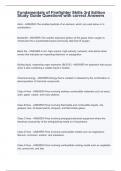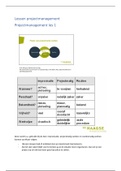-
1. Tentamen (uitwerkingen) - Fire fighter 100 questions & answers 100% correct
-
2. Tentamen (uitwerkingen) - Practice exam firefighter questions with correct answers
-
3. Tentamen (uitwerkingen) - Firefighter 1 final test, firefighter 1, fire 1 test prep questions with correct answ...
-
4. Tentamen (uitwerkingen) - Firefighter 1 & 2 study guide (questions 1-100) with complete solution
-
5. Tentamen (uitwerkingen) - Firefighter 1 class (all chapters) full test bank questions & answers 100% accurate
-
6. Tentamen (uitwerkingen) - Firefighter orientation and safety exam latest update
-
7. Tentamen (uitwerkingen) - Firefighter orientation and safety exam questions & answers 100% accurate
-
8. Tentamen (uitwerkingen) - Firefighter 1 exam questions & answers 100% accurate
-
9. Tentamen (uitwerkingen) - Fire fighter exam questions & answers 100% correct
-
10. Tentamen (uitwerkingen) - Mod 2 firefighter one exam with 100% correct answers
-
11. Tentamen (uitwerkingen) - Firefighter i nfpa standards exam latest update/100% questions & answers
-
12. Tentamen (uitwerkingen) - Firefighter skills chapters 1-3 exam questions with correct answers
-
13. Tentamen (uitwerkingen) - Exterior firefighter exam questions with complete solutions
-
14. Tentamen (uitwerkingen) - Firefighter 1 vocabulary exam 100% verified questions & answers
-
15. Tentamen (uitwerkingen) - Airport firefighter exam questions & answers 100% correct
-
16. Tentamen (uitwerkingen) - Fire fighter 1 - ofm exam study questions with correct answers
-
17. Tentamen (uitwerkingen) - Firefighter 2 review - all chapters exam questions with correct answers
-
18. Tentamen (uitwerkingen) - Basic firefighter 1 a+ exam questions & answers
-
19. Tentamen (uitwerkingen) - Firefighter 1: chapter 1 vocabulary exam questions with correct answers
-
20. Tentamen (uitwerkingen) - Advanced firefighter exam questions with correct answers
-
21. Tentamen (uitwerkingen) - Fire fighter roles and responsibilities exam questions with complete solution
-
22. Tentamen (uitwerkingen) - Airport firefighter course - with answers 100% verified
-
23. Tentamen (uitwerkingen) - Ohio firefighter exam questions & answers 100% verified
-
24. Tentamen (uitwerkingen) - Fire fighter i test 1 questions & answers graded a
-
25. Tentamen (uitwerkingen) - Basic firefighter 1 a+ exam questions & answers
-
26. Tentamen (uitwerkingen) - Mod 1 firefighter basic operations questions & answers 100% accurate
-
27. Tentamen (uitwerkingen) - Firefighter 1 top rated exam questions & answers
-
28. Tentamen (uitwerkingen) - Ohio firefighter exam questions with complete solution
-
29. Tentamen (uitwerkingen) - Chapter 2 firefighter safety and health (block 1/test 1) exam questions with complete...
-
30. Tentamen (uitwerkingen) - Mod a fire exam questions with correct answers
-
31. Tentamen (uitwerkingen) - Basic firefighting exam questions with complete solution
-
32. Tentamen (uitwerkingen) - Basic firefighting exam questions with complete solution
-
33. Tentamen (uitwerkingen) - Firefighter 2 exam questions with correct answers
-
34. Tentamen (uitwerkingen) - Introduction to the fire service and firefighter safety best graded exam questions
-
35. Tentamen (uitwerkingen) - Phase 2: exam ii-1 (firefighter ii) questions & answers graded a
-
36. Tentamen (uitwerkingen) - Firefighting terms exam questions with correct answers
-
37. Tentamen (uitwerkingen) - All chapters exam questions with correct answers
-
38. Tentamen (uitwerkingen) - Firefighter tools and equipment exam questions with complete solution
-
39. Tentamen (uitwerkingen) - Skills usa firefighting exam with 100% correct answers
-
40. Tentamen (uitwerkingen) - Essential of fire fighting 7. chapter 1 master test questions with correct answers
-
41. Tentamen (uitwerkingen) - Structural firefighting exam questions & answers 100% accurate
-
42. Tentamen (uitwerkingen) - Chapter one fire fighting questions with complete solution
-
43. Tentamen (uitwerkingen) - The fire service chapter 1 exam questions & answers
-
44. Tentamen (uitwerkingen) - Fire service organization exam questions & answers 100% correct
-
45. Tentamen (uitwerkingen) - Fire 101 exam questions with correct answers
-
46. Tentamen (uitwerkingen) - Fire 1 questions & answers 100% correct
-
47. Tentamen (uitwerkingen) - Fire fighting i and ii knowledge objectives a+ exam questions & answers
-
48. Tentamen (uitwerkingen) - Interior firefighting exam questions with correct answers
-
49. Tentamen (uitwerkingen) - Fire 101 exam questions with correct answers
-
50. Tentamen (uitwerkingen) - Firefighter 1 exam questions & answers 100% verified
-
51. Tentamen (uitwerkingen) - Fs1 chapter 1 a+ exam questions & answers
-
52. Tentamen (uitwerkingen) - Essentials of firefighting edition 7 chapter 1 exam questions & answers 100% accurate
-
53. Tentamen (uitwerkingen) - Chapter 1 exam questions with correct answers
-
54. Tentamen (uitwerkingen) - Chapter 1 essentials of fire fighting exam questions with correct answers
-
55. Tentamen (uitwerkingen) - Chapter 1 exam questions with correct answers
-
56. Tentamen (uitwerkingen) - Chapter 1 true/false exam questions with complete solution
-
57. Tentamen (uitwerkingen) - Firefighter exam questions with complete solutions
-
58. Tentamen (uitwerkingen) - Ft102q2,3,4 a+ exam questions & answers
-
59. Tentamen (uitwerkingen) - Basic firefighter written exam questions with complete solution
-
60. Tentamen (uitwerkingen) - Fire officer exam questions with correct answers
-
61. Tentamen (uitwerkingen) - Fire 78 final exam questions with correct answers
-
62. Tentamen (uitwerkingen) - Firefighter 1 exam questions & answers 100% accurate
-
63. Tentamen (uitwerkingen) - Chapter 1 exam questions with complete solution
-
64. Tentamen (uitwerkingen) - Firefighter basic final exam questions with correct answers
-
65. Tentamen (uitwerkingen) - Fire fighter duties and responsabilities questions with correct answers
-
66. Tentamen (uitwerkingen) - Chapter 1: introduction to the fire service and firefighter safety exam questions wit...
-
67. Tentamen (uitwerkingen) - Firefighter training questions & answers 100% accurate
-
68. Tentamen (uitwerkingen) - Firefighter health and saftey exam questions with verified answers
-
69. Tentamen (uitwerkingen) - Firefighter 1 exam questions & answers 100% accurate
-
70. Tentamen (uitwerkingen) - Nfpa 1001: firefighter i exam questions with correct answers
-
71. Tentamen (uitwerkingen) - Fire fighter 1-chapter 1-general roles exam questions & answers 100% accurate
-
72. Tentamen (uitwerkingen) - Fireman test questions with correct answers
-
73. Tentamen (uitwerkingen) - Firefighter 1 exam questions & answers 100% verified
-
74. Tentamen (uitwerkingen) - Chapter 1 fundamentals of firefighter skills exam questions with correct answers
-
75. Tentamen (uitwerkingen) - Specialist firefighting chapter 2 exam questions with complete solution
-
76. Tentamen (uitwerkingen) - Firefighter tools final exam questions & answers
-
77. Tentamen (uitwerkingen) - Firefighter 1 & 2 final exam questions with correct answers
-
78. Tentamen (uitwerkingen) - Firefighter emt 2021 final exam review questions with correct answers
-
79. Tentamen (uitwerkingen) - Interior ff study guide/ practice test (multiple choice questions) with correct answe...
-
80. Tentamen (uitwerkingen) - Fundamentals of firefighter skills 3rd edition study guide questions with correct ans...
-
81. Tentamen (uitwerkingen) - Advanced firefighter exam questions & answers 100% accurate
-
82. Tentamen (uitwerkingen) - Essentials of fire fighting final practice test questions with complete solution
-
83. Tentamen (uitwerkingen) - Firefighter 1 & 2 study guide (questions 101-200) with correct answersfirefighter 1 &...
-
Meer zien





